Things to Do and See Around Agrafa and...
The imposing mountain range of Agrafa...
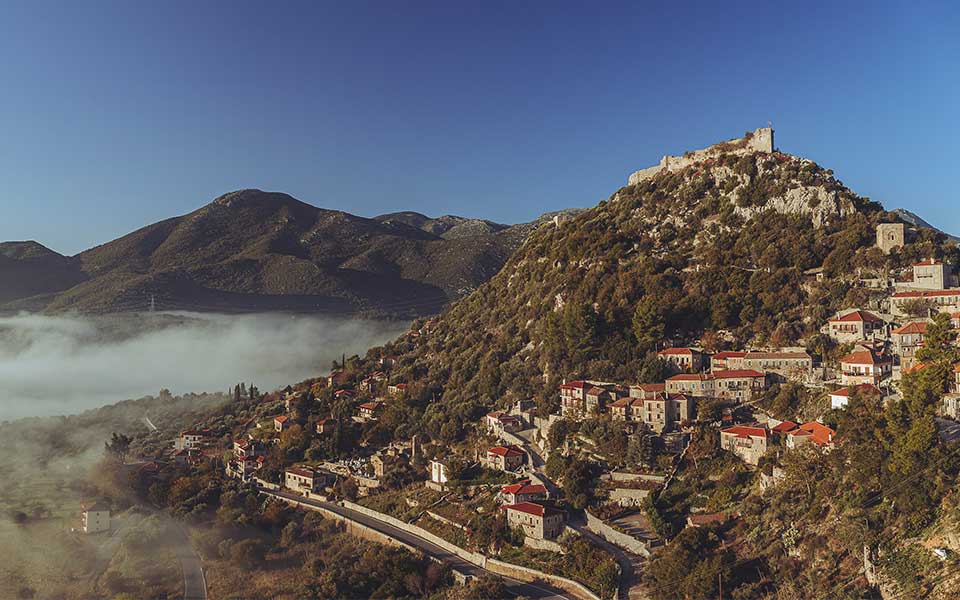
The characteristic architecture of Arkadia is evident in mountain village of Karytaina.
© Nikos Boutsikos, Nidibou Photography
One of the most historic villages in mountainous Arcadia, medieval Karytaina is a small but beautiful settlement, built in the area of ancient Vrenthi at an altitude of 582 meters. This small village of 250 people, built of stone and surrounded by lush vegetation due to the waters of both the Alfios, the largest river in the Peloponnese, and its tributary the Lousios, is an ideal destination for a weekend getaway in nature.
The castle town of Karytaina, built amphitheatrically on the hill that hosts one of the most important fortresses of the Peloponnese, passed through the hands of the Franks, the Byzantines, and the Turks before Kolokotronis made it his headquarters during the 1821 Revolution. According to legend, the knight Godefroy de Briere built this imposing castle in the early 13th century, when Karytaina was one of the baronies of the Frankish Principality of Achaea, and imprisoned his own wife in the castle’s foundations to strengthen the city’s bridge. The name Karytaina is also thought to be derived from the Frankish female name Caretene, which is common in Burgundy. Perhaps for this reason, this village of legends continues to attract more French travelers than Greeks, especially on weekdays. Although only 2.5 hours away from Athens, with its picturesque cobblestone streets, bridges, and Byzantine churches, Karytaina remains a quiet traditional village, ideal for getaways.
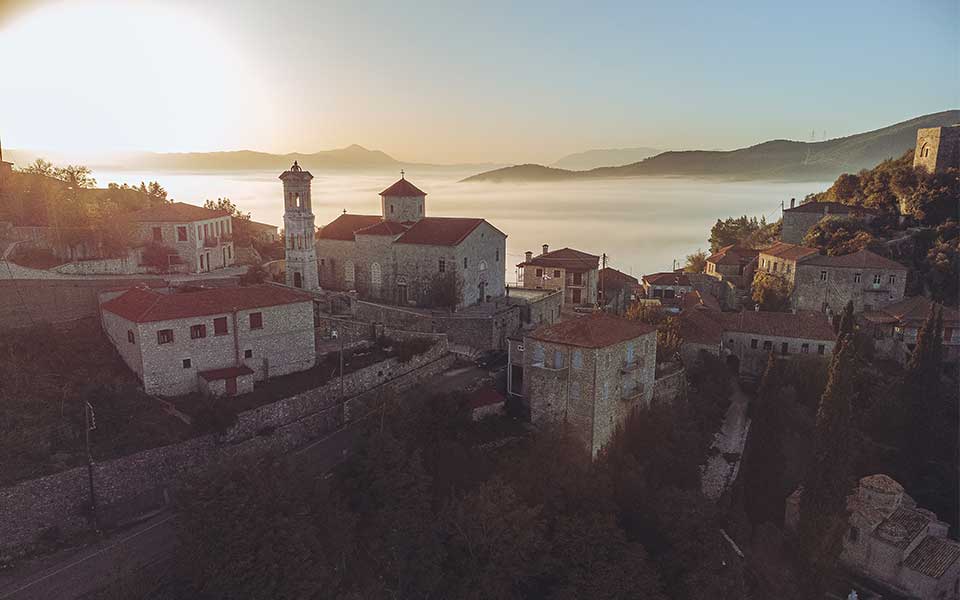
The medieval town of Karytaina, in the heart of the Peloponnese.
© Nikos Boutsikos, Nidibou Photography
Begin your exploration with a warm welcome at “Arctos” (Matzourani 4, Tel. (+30) 27910.313.41), a stone-built café-patisserie-restaurant in the heart of the settlement that will surprise you with its seasonal delights. Continue your tour to admire the tower houses, arches, and fountains of Karytaina. Descend westward to see the well-preserved 18th-century church of Aghios Nikolaos, regarded as one of the most important post-Byzantine monuments of the Peloponnese. Then climb to the castle to see the so-called “residence of Kolokotronis” and the Byzantine church of Panagia tou Kastrou. Unfortunately, the legendary fortress that controlled all passes connecting Arcadia to Messinia and Ilia is now closed, but the climb provides a unique view of both the village and the entire plain of Megalopolis.
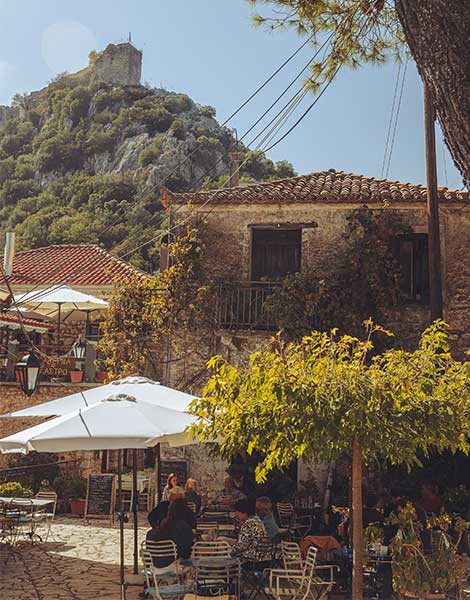
Greek writer and poet Nikos Kazantzakis referred to Karytaina as "the Toledo of Greece."
© Nikos Boutsikos, Nidibou Photography
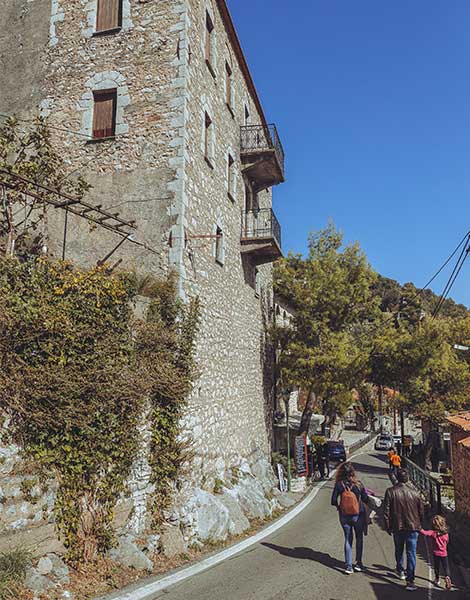
Karytaina remains a quiet traditional village, perfect for getaways.
© Nikos Boutsikos, Nidibou Photography
Karytaina’s most famous landmark is the stone arched bridge on the road to Megalopolis. This bridge, 12 meters high and 50 meters long, was built over the Alfios River by the Franks in the 13th century, and it is associated with yet another legend. Raul Manuel Melikis, a descendant of a Byzantine family, is said to have nearly drowned after falling into the river while attempting to cross the partially destroyed bridge. However, he was saved and decided to rebuild it in 1441, with the chapel of the Nativity of the Theotokos on one side to protect it. Much later, in 1984, the bridge of Karytaina with its five arches would become known as the “five-thousand drachma bridge,” as it was depicted on the reverse side of the blue banknote featuring Theodoros Kolokotronis. Today, this important landmark lies destroyed beneath the modern automobile bridge. Only three arches remain, and it is not safe to cross. Nevertheless, it’s worth visiting to see the remains of the bridge and the three old water mills that once operated in the area. From this vantage point, reminiscent of the Alcantara Bridge in Spain, you can see the village perched on the rock beneath the castle and understand why Kazantzakis referred to Karytaina as “the Toledo of Greece.”
Don’t forget to explore the rear part of the village, on the road to Atsilohos, where another stone bridge, less well-known but equally impressive, can be found. This bridge crosses over the azure Lousios River and is the perfect place to listen to the sound of the river’s waters, where, according to myth, the nymphs Neda, Agno, and Theisoa bathed the newborn Zeus. For lunch, return to the village center. Below the main square, at the taverna “To Kastro” (tel. 27910.311.13), you can try goat with trahana, rooster with hilopites (traditional pasta), bean soup and whatever else the kitchen has to offer, before ending your day in front of the fireplace.
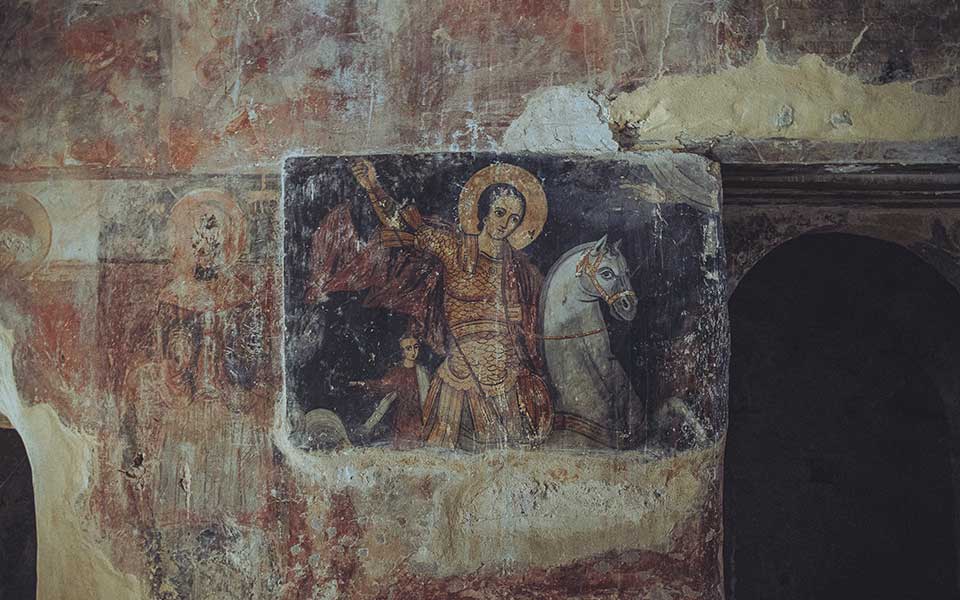
A wall fresco, inside the well-preserved 18th-century church of Aghios Nikolaos.
© Nikos Boutsikos, Nidibou Photography
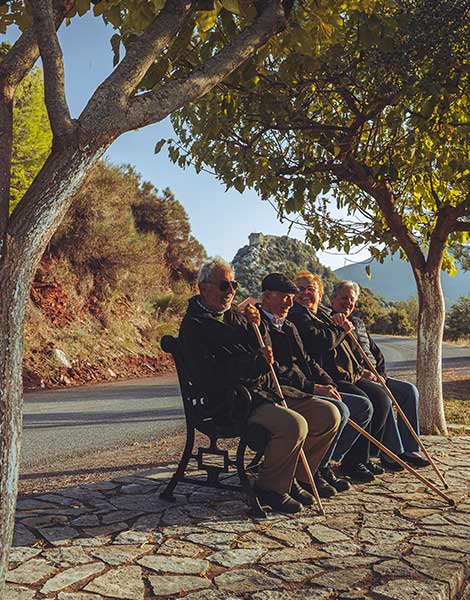
Enjoying the views overlooking the Alfeios Gorge.
© Nikos Boutsikos, Nidibou Photography
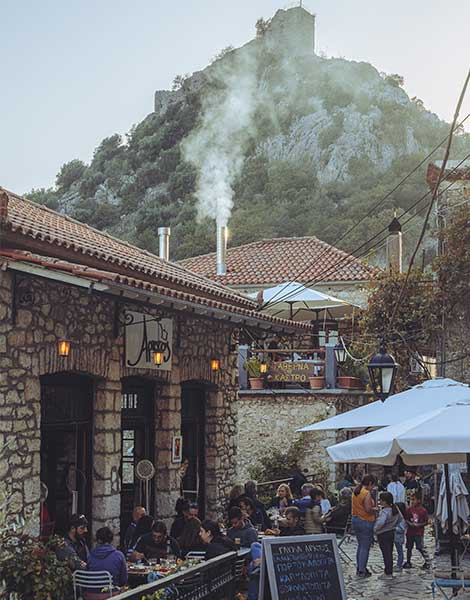
The Agora of Karytaina, with its cafés and small tavernas.
© Nikos Boutsikos, Nidibou Photography
Dedicate the second day of your getaway to a hike to discover the area’s hidden gems. National Trail 032, which passes through Karytaina, traverses central Peloponnese and intersects with many trails on Mount Mainalon and Mount Lykaion. One of these is the impressive and relatively easy trail that runs through the Lousios gorge. Enjoy a hearty breakfast, put on comfortable shoes, and get ready to explore Arcadia’s oldest monasteries and one of Greece’s most beautiful gorges.
You can start at the Monastery of Saint John Prodromos, which is only 17 kilometers away from Karytaina, and cross the Lousios heading towards the Philosophou Monastery, or vice versa. The route takes about 1.5 hours, is well signposted, and is certainly better maintained than the pothole-filled asphalt road that will take you to your starting point. Once there, don’t settle for the new monastery; instead, seek out the old one, which is one of Greece’s oldest Byzantine monasteries. You will find it hidden in a natural hollow in the rock next to the modern monastery on the western side of the gorge.
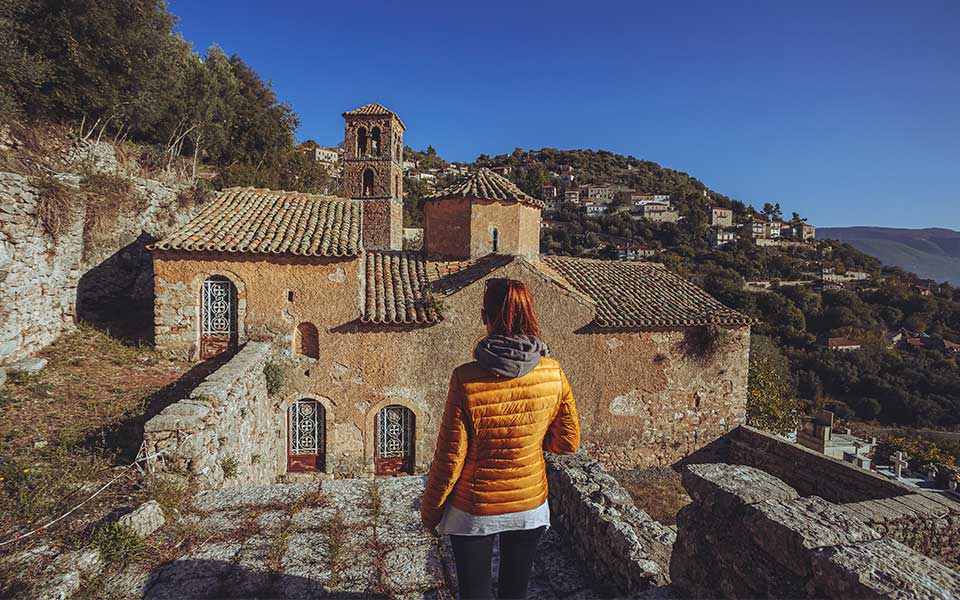
Τhe Byzantine church of Panagia tou Kastrou.
© Nikos Boutsikos, Nidibou Photography
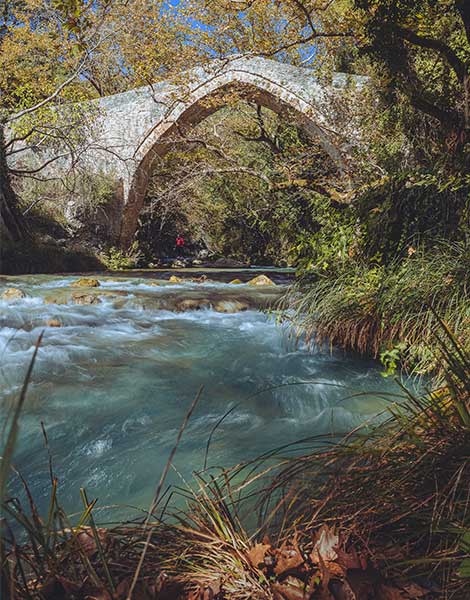
A stone bridge over the Lousios River.
© Nikos Boutsikos, Nidibou Photography
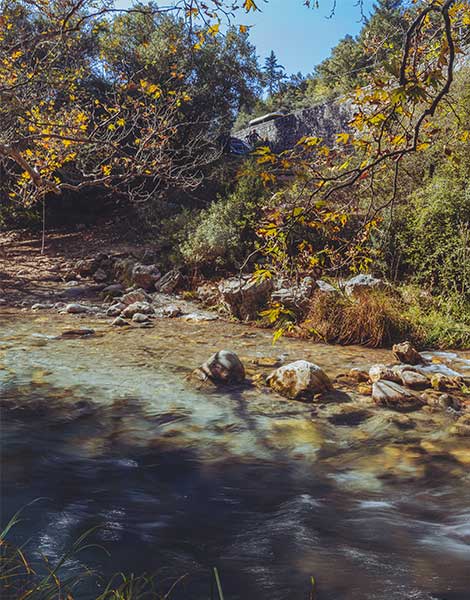
The Lousios River
© Nikos Boutsikos, Nidibou Photography
On the other side of the gorge, its “Lady,” the Prodromou Monastery, is nestled on a steep cliff 200 meters above the riverbed . This historic 12th-century monastery, which served as a stronghold against the Turks during the 1821 Revolution, is only accessible via two footpaths. If you don’t want to take the Mainalon Trail from the Philosophou Monastery, you can get there by walking about 800 meters from the chapel of Metamorfosis, which is located on the highway, 9 kilometers from Stemnitsa. Whichever path you choose, visit the Monastery to light a candle and listen to one of the few remaining monks narrate its history while sipping on your Greek coffee and eating lukum (Turkish delight). Don’t pass up the opportunity to enjoy the best view of the gorge from the Monastery’s balconies. When you have had your fill of beauty, you’ll be ready to depart.
If you have time, make sure to return via Dimitsana to enjoy wild boar at “Kapilio ton Athanaton” (Lampardopoulou 63, Dimitsana), which overlooks the Lousios Gorge, and to visit the Open-Air Water Power Museum, which will help you understand how the history of the area is linked to this river. After seeing the watermill, the miller’s house, the distillery, and the tannery, visit the gunpowder mill at the lower level of the museum to see how this military resource defined the region’s role in the 1821 Revolution. Finally, stop by “4 Seasons” (Dimitsana, Tel. (+30) 27950.315.99) for a warm drink and a dessert before heading back.
The imposing mountain range of Agrafa...
The charming port city of Volos...
From the salt-sprayed islands to the...
A steep and curvy drive high...